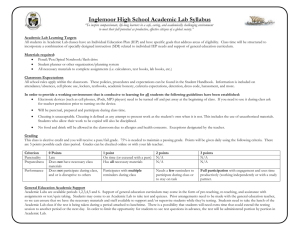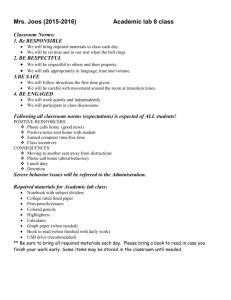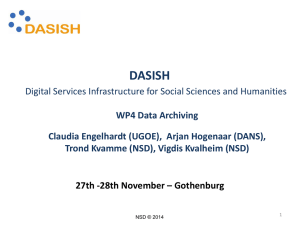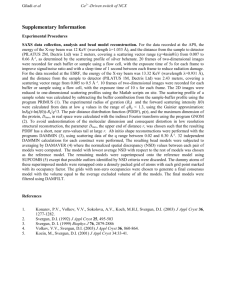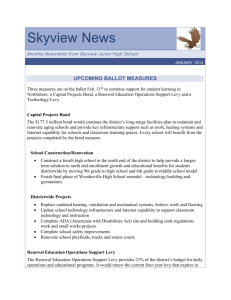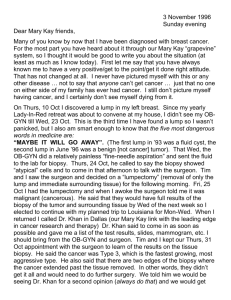Context of Feasibility Study - STATISTICS TIMOR-LESTE
advertisement
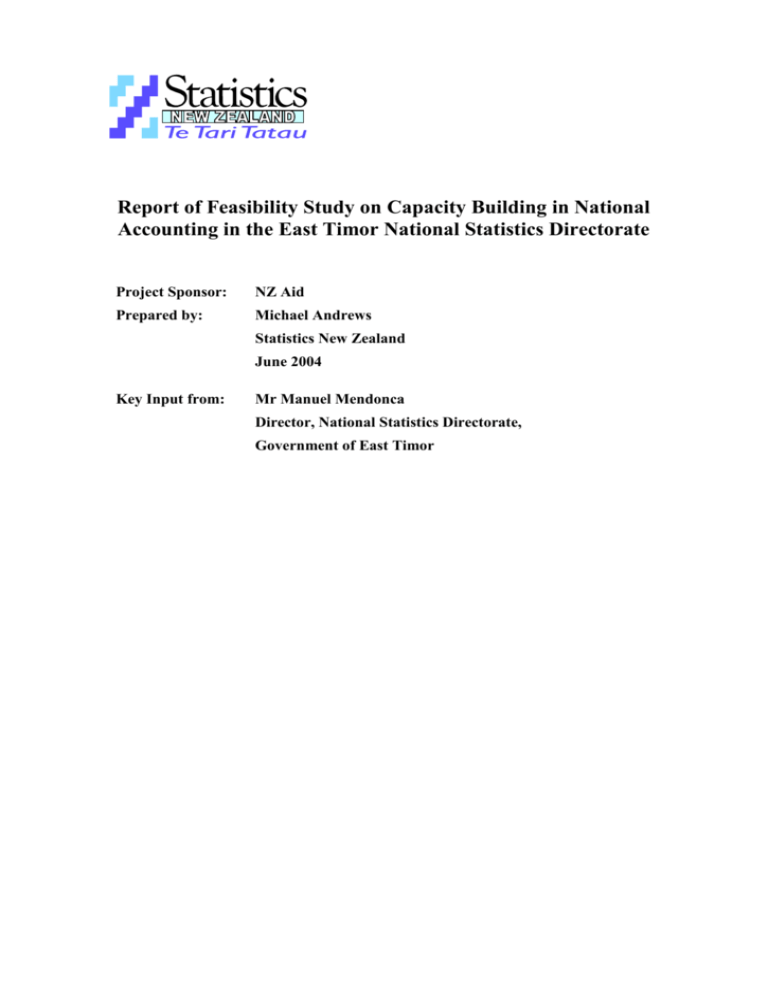
Report of Feasibility Study on Capacity Building in National Accounting in the East Timor National Statistics Directorate Project Sponsor: NZ Aid Prepared by: Michael Andrews Statistics New Zealand June 2004 Key Input from: Mr Manuel Mendonca Director, National Statistics Directorate, Government of East Timor Page 2 Executive Summary This feasibility study has been conducted to assess how Statistics NZ could provide long term assistance to the National Statistics Directorate of Timor-Leste, specifically for national accounts statistics. This report is addressed to the executive of Statistics NZ, and NZAid. The study identified the key uses of the national accounts, what national accounts statistics are needed, and what support the NSD needs to build its capacity over the next several years. The NSD has considerable ability in conducting surveys of households, and recently upgraded the CPI collection and begun compiling external trade statistics. However, the NSD currently has little experience of producing analytical outputs, particularly from economic or financial data. Therefore, it will take a number of years for the NSD to build up to a level of experience and knowledge needed to produce national accounts without external assistance. This report provides a proposed plan for a series of missions to Timor-Leste. These missions will provide both training and statistical assistance to compile the accounts while the NSD staff develop their skills and knowledge. It also outlines available data sources, possible methodology for developing time series for value added by industry, and identifies areas where additional collections may need to be developed to fill critical data gaps. Recommendations: 1. That two visits per year be undertaken. This maintains regular face to face contact, while still requiring the NSD to take responsibility for the bulk of the work. 2. That remote support via email and telephone be provided on an ad hoc basis, to answer queries as they arise in the NSD’s work. 3. That SNZ liase with the Boston Institute of Development Economics while they visit Dili from July 2004 to develop methodology and compile the national accounts for 2001-2003. Ideally this would include a face to face meeting while BIDE are in Dili. 4. That Statistics NZ keep the Director NSD informed of upcoming regional training courses and meetings relevant to national accounts, and which would assist the NSD in capacity building. 5. That Statistics NZ begin to liase with the new IMF Statistical Advisor to the Director of the NSD after their arrival in Dili in approximately September, on matters relevant to the national accounts. Context of Feasibility Study A number of events are occurring, or will occur shortly, which influence the recommendations of this feasibility study. These include: 1. The first census of population is under way. Enumeration occurs in July, and building the framework for the census is absorbing nearly all the resources and energy of NSD staff (as well as the UN personnel working on it). Because of its high importance (and profile), the options for additional work being undertaken by NSD staff are very limited. As well as most of the existing staff of the NSD, many extra staff have been employed for the census work. A number of these extra, Feasibility Study Report – Timor Leste.doc, June 2004 Statistics New Zealand Page 3 2. 3. 4. 5. temporary staff are proving capable and would be good candidates for work on economic statistics after the census concludes. However, they are currently fully committed to census work, and will be so until at least August. Also, the budget of the NSD, and government recruitment constraints limit the scope for the NSD to take on additional permanent staff. The Statistical Advisor (IMF) to the Director of NSD departed in February. Since then, the Chief Census Advisor has been providing limited assistance to the Director where possible. A replacement advisor has been appointed, but will not begin until approximately September. At these early stages of establishing the NSD a statistical advisor contributes a great deal to the direction and development of the statistics office and its staff. While in Dili, I also assisted the Director on a number of matters unrelated to my mission, and he asked if it would be possible for someone from Statistics NZ to fill the gap as advisor until the IMF appointee begins in September. An agreement has just been reached between the NSD and the World Bank, to reengage the Boston Institute of Development Economics (BIDE) consultants to develop methodology and compile updated accounts to 2003 (BIDE derived the original 2000 national accounts). This work is scheduled to begin in July 2004 and be completed by approximately October (dates are yet to be finalised). Because the accounts up to 2003 will have been compiled by the end of 2004, future Statistics NZ TA’s can focus on helping the NSD build its capacity to produce national accounts using the methodology developed by BIDE. This would be via formal and on-the-job training, and long-term support and development, as described in this proposal. NB if the BIDE consultancy had not been undertaken, a Statistics NZ TA would largely have comprised developing methodology and compiling the initial estimates for most of the first two years. The BIDE TOR include a requirement for NSD to provide counterpart staff to work with BIDE – resolving this problem must become a high priority for the Director of NSD (however, refer to point 1 above re the census). It is recommended that to begin the support to NSD, Statistics NZ should undertake a short mission to TimorLeste near the end of the BIDE consultancy. This would help the transition from the initial development and backdating phase done by BIDE to the ongoing support and advice by Statistics NZ. A recent TA project has enhanced the CPI collection, broadening coverage beyond Dili. This will provide vital source data for parts of both current and constant price GDP estimates. The World Bank is also considering sponsoring a household survey in 2005 to update the 2001 Poverty Survey – this could be expanded into an income and expenditure survey and provide data to update the weights for the CPI, and to establish a benchmark of household consumption. Another recent TA project has developed systems for Customs records to be produced regularly as statistical outputs by the NSD. This is another key input data source for the national accounts estimates. The consultant who developed these systems will shortly return to Dili for a review of progress and results, and proposes to provide remote support. Assessment of User Needs The key priority is to produce annual current and constant price GDP by industry and by expenditure on GDP. This is predominantly structural data, to show the size and Feasibility Study Report – Timor Leste.doc, June 2004 Statistics New Zealand Page 4 structure of the economy. Users assign a lower priority to national income accounts, balance of payments statistics, and to quarterly or monthly indicator statistics. I repeat, also, the recommendation in PFTAC’s report from August 20031 that the Director NSD form an advisory committee to guide and help co-ordinate statistical activities across all government offices. At present different departments develop new collections without consulting other potential users, either within government or outside. This can result in inefficiencies within government, and additional and unnecessary costs to donor agencies. At least some of these activities could be combined. For example, the World Bank has expressed interest in running a new Poverty Survey to update the one run in 2001 – this could best be developed as a general purpose household survey to; collect data on poverty, collect data on subsistence production for the national accounts value added estimates, and collect household consumption expenditure information for use in the national accounts and in updating the CPI weights Organisation Ministry of Finance & Planning Macro-economic and Tax Policy Unit Labour & Solidarity Dept Banking & Payments Authority IMF World Bank ADB UNDP Highest Priority Needs Establish statistical infrastructure - office and statistics law. National Accounts GDP, Trade, Prices, Census, Agriculture, Unemployment Census GDP, prices, trade Other Needs & Comments Learning from the best is seen as being more important than using resources in the Indonesian Bahasa language Cost of living survey (=HIES?), monthly CPI desirable (needs greater co-ordination between organisations – LSD ran a disability survey in 2001 without involving NSD) BOP - but acknowledge this could wait until other things established (providing technical advisor to Director of NSD, also four at the Banking & Payments Authority) Funded BIDE NA project Inclusion of subsistence production in 2002. Contract signed to in the estimates. Envisage funding compile accounts 2001-03. an update of the 2001 Poverty Poverty data. survey in 2005, and may consider linking this with an HIES. Helping with trade project Would like to be involved in more projects Currently updating the Willing to consider funding a Human Development HIES/Poverty study in 2005 Report (to be published 1 Review and Action Plan for the Statistical System in Timor-Leste, August 2003, Report prepared by Philip Turnbull, Statistics Advisor, Pacific Financial Technical Assistance Centre. Feasibility Study Report – Timor Leste.doc, June 2004 Statistics New Zealand Page 5 UNIFEM May 2004) Promoting recognition of role of women in society and economy, and therefore policy makers. Classifications used should reflect Timorese society and needs, as well as international standards. Classify key statistics by gender. May be able to assist with NA development via an expert from the Indonesian statistics office. Considering a small-scale survey of time use in 2005, to raise awareness of issues among policy makers – could be useful in estimating subsistence and informal sector production. Summary of Proposed Statistics NZ Visits, 2004-2007 (Further detail is provided in the table following this section) Date Main Purpose May-June 2004 Oct 2004 March 2005 Feasibility study Learn BIDE methodology used for 2001-2003 accounts Run Intermediate national accounts course. Collate source data needed to update accounts to 2004. Develop new collections as needed to refine estimates. Run Intermediate national accounts course. Update accounts to 2004, revise prior years if needed. Incorporate data from new collections into methodology. Onjob training. Check and analyse quarterly tax data as published economic indicator. Update accounts to 2005, revise prior years if needed – use new sources and methods if suitable. Develop initial collections needed for balance of payments. Run introductory BOP course. Update accounts to 2007. Sep-Oct 2005 April 2006 Sept 2006 Mar 2007 Aug 2007 Feasibility Study Report – Timor Leste.doc, June 2004 Statistics New Zealand Page 6 Feasibility Study Report – Timor Leste.doc, June 2004 Statistics New Zealand Page 7 Proposal for Statistics NZ support of Timor-Leste compilation of National Accounts, and capability development (Tasks in italics are not for Statistics NZ) Primary Compilation Tasks Duration 1 May – Feasibility study in two parts: (1) 3 weeks Jun 2004 plan for developing counterpart staff in NA's; and (2) plan for continuing the compilation of the NA's as developed by BIDE Who Statistics NZ, with input from NSD Secondary Compilation Tasks Identify existing data sources to be used for compiling the accounts. Also, identify industries or other areas that require new data sources or methods, and begin process of planning to collect this data. Capability Development Help Director NSD identify potential candidates for future NA development work/training. Comments Completed. While the NSD have a number of capable staff at present, they are all committed to the census until approximately September. NB the development of methodology and assessment of existing available data will be done by BIDE as part of their consultancy (task 4). 2 Jun 2004 Begin capture and classification of tax data, and other data already being collected by other govt offices, eg, agriculture. NSD Requires commitment of NSD (and the Govt) to provide additional staff to begin their development of economic statistics. Also needs commitment and assistance of other govt agencies, to provide access. May be possible to outpost the NA staff to the tax office to gain familiarity with the data? Dependent on suitable staff being available - may not be possible due to census. A very important task for NSD at this time is to get commitment to the long-term support for economic statistics in a co-ordinated way, eg via an advisory council, to include tax office, agriculture, mining, etc. 3 Jun 2004 Trade system project – consultancy Gavin Lucas 4 Jul – Oct 1. 2004 – dates to be 2. finalised 3. BIDE 4. 5. 6. 7. establish classifications 4 months (industry, institutional sector, transactions, etc) gather available data set up preliminary methods and processes to capture, classify and analyse this data compile preliminary estimates of value added, in current and constant prices repeat steps 1-4 for expenditure components consolidate accounts, reconciling production and expenditure estimates finalise methods and estimates Feasibility Study Report – Timor Leste.doc, June 2004 Trade data already available – proposed additional project for offsite support, plus occasional short visits to check progress, etc Set up spreadsheets for the methodology, including for analysis of source data, ie, the NA s/s 'system'. Fully document data sources, processes and methodology (methodology to be published with the estimates). (NB data and estimates are needed separately on the formal/market sector and the informal sector - this will largely be driven by data sources, ie, tax and other admin data will largely cover the formal sector). Statistics New Zealand Begin training of counterpart staff in collection and analysis of economic data. Begin training in NA concepts and methods - general and specific for the methods used. Ideal if NSD can begin the gathering of existing data ahead of BIDE visit, with agreements with Tax office, Agriculture dept, etc, to supply the data - this arrangement must continue after BIDE project is completed, for future updates, etc (refer task 2 above). Begin as soon as possible, if suitable staff are available. NB all existing NSD staff will largely be committed to their existing work (trade, CPI, etc) or to census. (See also the comment below, re Statistics NZ keeping in touch with BIDE during their mission to develop methodology.) Page 8 5 Oct 2004 - date is dependent on timing of BIDE mission Primary Compilation Tasks Visit near the end BIDE’s consultancy, to learn their methodology, etc, for ongoing compilation/support to NSD. 6 Nov 04 - Establish processes for ongoing Mar 05 gathering and analysing tax and other admin data, for 2004. Duration 2 weeks Who Statistics NZ Ongoing NSD Secondary Compilation Tasks Identify areas that require additional data to update assumptions or fixed proportions used in the BIDE estimates - develop plans for collecting this data. Provide input to design of HIES if confirmed for 2005. Help the NSD staff in gathering 3 weeks and analysing tax and other administrative data for 2004, and any revisions for earlier years, using same procedures established by BIDE. Check the work done to date on this data, by NSD. Statistics NZ, with input from NSD. NSD to run the new surveys. Design and develop new surveys for additional data as needed to update in future the fixed ratios, assumptions, etc, made by BIDE. Include additional price information needed to supplement the CPI data for good constant price estimates. 8 Apr Aug 05 Continue to gather and process tax ongoing and other admin data. NSD Run the small-scale surveys developed in task 7. Capture the data and check it for accuracy, etc. Feasibility Study Report – Timor Leste.doc, June 2004 Comments Ideally, would keep in touch with BIDE during their visit, while they develop methodology, systems, etc - is this possible? Timing dependent on BIDE TOR. Need to identify tasks for NSD staff to work on, to continue their involvement in national accounts and economic statistics in general. Liase with Statistical Advisor. Become familiar with BIDE workings, methodology, etc. 7 Mar 2005 9 Sep - Oct Update the estimates to 2004, using 6 weeks 2005 the methodology established by BIDE. Capability Development Work with BIDE to pass on some of their knowledge of methods, etc to NSD staff, and confirm the plan for staff development for next two years. Statistics Check whether any revisions are NZ with needed to earlier years, due to assistance additional or revised source data, etc. by NSD Statistics New Zealand Run an introductory national accounts course on; classifications, industry production a/cs, expenditure aggregates, consolidated a/cs, current and constant prices. Requires the NSD to have identified and committed at least two staff to become full time and permanent national accountants. Training should be provided to these staff, and also others who will provide back up. Include staff from other govt offices if appropriate, data suppliers and users of the NA's - NSD to advise. Run an intermediate national accounts course – repeat some parts from intro course, and add more depth where appropriate. To be mainly practical training. Timing to be confirmed, dependant on when the tax and other crucial data sources will be complete enough to compile the estimates. Much of the training to be on-the-job, with NSD staff processing and analysing the data using the BIDE methodology to make the estimates where possible. Page 9 Primary Compilation Tasks Duration 10 Oct 05 - Continue to gather and process tax ongoing Jan 06 and other admin data. Who NSD Secondary Compilation Tasks Run the small-scale surveys developed in task 7. Capture the data and check it for accuracy, etc. Capability Development Nominate staff to attend the SIAP national accounts course (refer task 11). Comments Obtain access to the quarterly tax data, with ongoing supply arrangement. Arrangement must include approval to publish results along with other economic indicator data. 11 Jan – Mar 2006 Attend Module III training course on National Accounts at SIAP, Japan - part of the three module, six month Group Training Course on Core Official Statistics 12 Apr 2006 Analyse the data from the small4 weeks scale surveys. Build the new data into the methodology where appropriate, analyse the effect of this new data on the NA estimates. Statistics NZ, with NSD Check and analyse quarterly tax revenue data in preparation for publication if suitable as a short term indicator of the formal sector – assist NSD to prepare for publishing if suitable. Analyse results of HIES for incorporation into the accounts (assumes HIES proceeds) – is training on analysis part of HIES project? On the job training in analysis of source data, formal training in quarterly data methods, seasonal adjustment, etc. Training on use of HIES for NA's. 13 May 06 onward Continue to gather and process annual tax and other admin data. NSD Begin regular publication of quarterly tax revenue data, as a short-term economic indicator, along with trade and CPI data. Development of NSD's Requires NSD's ongoing commitment to own timetable, processes producing these data, and a regular publication. for publication, etc. Dissemination should include via the internet. Nominate staff for IMF Washington National Accounts course in November 06 (if not attended SIAP course) Feasibility Study Report – Timor Leste.doc, June 2004 two months 1 NSD NA staff ongoing Three modules: Statistical and Survey Methods, Demography and Social Statistics, National Accounts. The goal is to get an NSD officer at the NA module. Try to get other staff to attend the other two modules relevant to their specialities. Statistics New Zealand Do not publish revised accounts incorporating the new data from the small-scale surveys and HIES at this time – wait until the next update visit. Do this work in a separate complete copy of the system to maintain integrity of the published accounts and their workings. Time this visit for just after the end of the SIAP course (if attended), to reinforce learning from SIAP course - get the attendee to run some of the training sessions for other NSD staff. Page 10 14 May – Aug 2006 Primary Compilation Tasks Duration Analyse source data, enter into spreadsheets, and compile the NA's for 2005. 15 Sep 2006 Update NA estimates to 2005 4 weeks compile using both the existing and updated methods (ie, latter to include the additional data collected, eg, HIES). Nov 2006?? 16 Mar 2007 Who NSD Secondary Compilation Tasks Capability Development Comments First set of estimates for NSD to take the lead in compilation. Aim to complete the initial estimates prior to next visit by SNZ. Determine when there will be enough annual data available to compile the annual NA's - advise SNZ to visit at that time, aiming for earliest possible publication (without cutting quality). NSD with advice from Statistics NZ Important to analyse the effects of methodology and source data changes, and be prepared to explain and justify the differences. Publish on the new method basis, if results are acceptable, with full explanation of changes made. Reinforces the previous training, by getting NSD to take the lead. Reassess future needs for capability building, and refine plan for support over next two years. The NSD takes the lead in compiling the nominal a/cs using existing methods. NSD should (a) obtain the necessary data, (b) input the data into the relevant worksheets, (c) derive the output tables. Statistics NZ's role is to check and confirm the workings and analysis. Calculating on both bases enables comparison of estimates, before and after changes to methodology. Attend IMF National Accounts training course (if don't attend SIAP course in Jan 2006). Not scheduled for 2005 (too soon for NSD anyway), so may be in 2006. Usually run Oct/Nov, applications in by May. Try to get NSD staff to attend either this or the SIAP course. Training in basic BOP concepts, survey development cycle, etc Dependent on location for BOP to be produced, ie, NSD or the Banking & Payments Authority – this needs to be decided by Statistical Advisory Board during 2006? 4 weeks Develop initial collections needed 4 weeks for Balance of Payments current account - trade in services. Should provide enough data for the national income a/c also. 17 Mar 07 – Run the new BOP surveys. Aug 07 Feasibility Study Report – Timor Leste.doc, June 2004 ongoing Statistics NZ. NSD to run surveys NSD Analyse and cross check results with other sources where possible, eg, tax data. Statistics New Zealand Note that this needs to be in addition to the ongoing compilation of NA's, which must be completed by the end of July (date to be confirmed, dependent on critical source data availability) Page 11 18 Aug 2007 Primary Compilation Tasks Duration Check and analyse NA estimate for 4 weeks 2006, done by NSD. Who Statistics NZ Secondary Compilation Tasks Check on progress with the BOP surveys. Training attachment with a National Accounts division of another statistics office (eg, Statistics NZ, Australian Bureau of Statistics, Indonesia). Capability Development Confirm that NSD can continue compilation of NA's independently. Comments NSD would have compiled the estimates for 2006, before Statistics NZ visits. Review timing of source data – determine how to make the estimates more timely. Either by obtaining the source data earlier, or by using alternative data and methods. For Statistics NZ, this would need to be arranged around the schedule for relocation of the division to Wellington. Ongoing support and development tasks: 1. Provide remote support to NSD staff on national accounting queries, and provide advice on relevant capability issues as they arise, etc, where these cannot wait until the next mission. NB it is not expected that such support would absorb significant amounts of time. 2. Provide Director NSD limited advice on planning and operation of economic collections as appropriate. During the term of the IMF Statistical Advisor this is unlikely to be needed. However, liaison with the Advisor while there would be useful to maintain the ongoing contact with the NSD, and keep up to date with the direction given by the Advisor and how this relates to Statistics NZ being involved for the long term. 3. Keep Director NSD informed of upcoming relevant regional training courses (on NA's, BOP, economic data analysis, etc), where possible. Arrange for NSD to attend where appropriate – NB it will probably require external funding for NSD to attend. 4. Keep Director NSD informed of upcoming relevant Asia and Pacific regional co-ordination, etc, meetings, with SPC, ESCAP, etc, and other relevant work being done in the region. Feasibility Study Report – Timor Leste.doc, June 2004 Statistics New Zealand Page 13 Possible Methodology for Value Added by Industry (NB Comments relate to current prices estimates only. It is assumed that there is sufficient price coverage in the present CPI for basic price deflation methods for constant price estimates, and for estimating nominal outputs for agriculture using a volume times price method. This will need to be confirmed, and shortcomings identified. Also, the possible sources and methods listed below are indicative rather than exhaustive – BIDE will explore the possibilities further) BIDE Methodology for 2000 Data Method used source used 1 Agriculture Dept of Value added, in Agriculture USD, estimated estimates relative to level of of production in 1997 production, (considered a made in typical year). Detail June 2000 only for total food crops, other crops, livestock, forestry and fisheries. Small adjustment made for government agriculture activity. Industry 2 Oil & gas Unknown Average daily volume of oil produced x days per month x USD price per barrel. This is reconciled to the actual receipt of FTP and monthly value adjusted by this reconciliation factor. Deduct some intermediate Feasibility Study Report – Timor Leste.doc, June 2004 Updating Methodology Future Development Possible sources Possible methods Comments No explicit calculation of volume or price change or level, just a total adjustment, eg 70% for food crops. No adjustment for change in VA to output ratio. PFTAC report says subsistence farming is not included - but what was in the Indonesian estimates that these are based on? Begin with the results of the Household Poverty Survey run in 2001. Contains considerable detail on volumes of agriculture production, destination of food production (own consumption, sale, wastage, etc), livestock holdings, use of inputs such as fertilisers and seeds. Also contains some information on gathering of timber for building or firewood, and fishing activities. Have prices in CPI need adjustment to farm gate price vs town market (most production is for own consumption)? Try to work with agriculture dept, rather than run own surveys! Mystery on intermediate inputs calculation and the VA ratio - seem to be deducting inputs twice. Who owns the plant, etc Australian based companies under jointly owned regulatory authority. Only tax and royalties are flowing to ET, and may be some wages of ET oil workers? Need this monthly volume data, and the USD price per barrel for each month. Available from the Government. Need to debate the 50% value added to output ratio (cf 90% claimed for Indonesia). What are the intermediate inputs? Comments Statistics New Zealand Volume x price ideal for output enables current and constant price calculations to be made consistently. What are the non-food crops? Coffee only export - needs to be consistent with the trade data/exports value in ETA/BOP. Important component in terms of "employment", with a high proportion of people dependant on farming. Some debate on the correct treatment of the flows here – PFTAC suggests showing oil extracted by a foreign owned notional enterprise and they export it to Australia – and inputs, capital used etc also would need to be estimated and included in the a/cs, with repatriation of profits overseas, etc. Page 14 2 Quarrying none inputs then apply a 50% VA/GO ratio. Assumes fixed ratio VA/GO ratio from Indonesian of output of IO tables (for Timor as quarrying to output province or all of Indonesia?) of construction =5%, then fixed VA/GO ratio of 60% 3 Manufacturi Survey of ng Small and Medium Industries, Div of Industry, Mineral Resources & Tourism, Apr/May 2001, released Sept 2001 Sample survey results expanded to population estimates. Value added then estimated as sum of COE (# of employees x assumed average wage) + net op surplus at 10% of output + 10% depreciation. Adjusted back to 2000 for no of businesses operating and inflation rate. 4 Electricity, GovernGas & ment Water budget/ accounts All govt owned/operated units, so calculated as part of the overall calculations for govt. Only electricity, and water & sanitation Feasibility Study Report – Timor Leste.doc, June 2004 How good was the population information (sample fraction = 4?)? Business registration is a formal process, but unsure how well it is policed in practice. Coverage out of Dili? Is the US$4.50 per worker per day reasonable – update using annual tax data? No govt manufacturing? Why some sample data in USD, some in Rupia (but not all of the Rupia data is used)? Construction income is identified on the annual tax form, and withholding tax is specified on it. Therefore, tax should be a good indicator of the level of activity. Tax provides data on input costs. Mixture of businesses in this industry - registered companies paying tax, and small businesses (eg, those gathering gravel from the river in Dili). Tax records will provide good data for the registered, tax paying businesses. Concentrate on those activities likely to show significant change, eg, vehicle repair, concrete making? Any plans to repeat survey could NSD assist and get some changes made to the survey for NA purposes? Then need indicators for the small business activity. Has the DIMRT run further surveys since 2001? See also comment in possible future method column. Get this from the govt's accounts, as part of the overall calculations for govt. Statistics New Zealand The estimate indicates this is a significant activity. Likely to show marked changes in activity since 2000 due to the road repair work done by the UN, which will decrease during 2004. Infer change in small business activity from changes in other industries, eg, rice milling by agriculture production. Ie, a commodity flow method – needs data from the other end (ie source or destination of the goods)? Classification used in the survey? Locally focussed are these all the important activities? If use a commodity flow method for small business activity, need to keep this in mind when developing methodology for the upstream activities. A lot of electricity is generated privately using diesel generators – if all used in-house then this is just secondary activity. Page 15 authorities. 5 Construc- Budget/ tion – accounts government capital expenditure Get this from the govt's accounts, as part of the overall calculations for govt. 5 Construction – private business sector Construction is specifically mentioned on annual tax form, and income from construction is subject to withholding tax. Will be a lot done on own account by small businesses, and therefore not sold – how to measure this? 5 Construction – residential housing capital expenditure 5 Construction – value added Govt in two parts: actual construction activities reallocated, and the work done by international agencies. No source Private business data sector is estimated at 25% of govt. Household survey + NGOs' expenditure Housing is based on receipts by households from NGOs in the household survey plus own spending, adjust back to 2000 using a ratio of spending in the survey to spending by NGOs in 2000. Mixes sources for the year adjustment - one from NGOs' spending, the other from receipts by households. Better to use NGOs' spending in both years - or does this implicitly adjust for household underreporting too? How did the household survey collect data on USD spending on own a/c - much material is from bush? Estimate first output by sector, then apply VA/GO ratio (45% from Indonesian IO tables). Feasibility Study Report – Timor Leste.doc, June 2004 Relevance of VA/GO ratio from Indonesian times to now, under UN mgmt, plus NGO work, etc? Annual data from the NGOs of their spending on this. Some may be included in tax data. May need to use population growth estimates, with an assumption about the rate of deterioration requiring reconstruction. See comments => Annual tax returns provide enough information to estimate intermediate inputs and value added for the formal sector. Statistics New Zealand How much of this work is actually domestic production, vs done by UN agencies and gifted to TL on completion, eg, road building? May need to debate this treatment. Is cement made locally or imported if imported this is an indicator of inputs (treatment of imports by UN agencies?). How much traditional housing is produced each year, in terms of regular construction due to natural deterioration and weather damage? If significant this could be estimated separately to the longer lasting styles using corrugated iron and concrete blocks - higher rate of depreciation too in the rental calculations. Something to consider as part of the HIES for 2005? Page 16 6 Trade Nil Trade – estimated VA as same proportion to total GDP excluding oil as for average 199398 in Indonesian estimates. A lot of employment in small-scale trade, and could be a reasonable indicator of income for many urban households? Annual tax returns provide enough information to estimate intermediate inputs and value added, for the formal sector. Imports and exports data - give value and volume of externally traded goods. Treatment of imports by UN agencies? Need alternative for street vendors, etc. 6 Hotels Unknown 6 Restaurants Unknown 7 Transport – Governgovernment ment accounts Hotels - all hotels are known, revenue estimated as no of tables x average wage per employee x no of employees/tables, net operating surplus as 120% of wages bill (in Dili, 80% outside), and depreciation as 10% of profits. Hotels - all hotels are known. Revenue estimated as no of rooms x average price x average occupancy, times Indonesian IO based VA/GO ratio. Refers to "repatriation of refugees", by mode road, sea, air 7 Rentals and Services Receipts / Tax rate Allied tax receipts Services Feasibility Study Report – Timor Leste.doc, June 2004 Lots of assumptions, but apparently good coverage of businesses. Use the tax data. Also, obtain the same data as used by BIDE for 2000 to compare with tax. There is a service tax on hotel services, means that all hotels are registered and data available on turnover. Also, they will be filing annual tax returns. Lots of assumptions, but apparently good coverage of businesses. Use the tax data. Also, obtain the same data as used by BIDE for 2000 to compare with tax. There is a service tax on restaurant services. Also, they will be filing annual tax returns Get this from the govt's accounts, as part of the overall calculations for govt. Services tax receipts, as used by BIDE. Vehicle rentals are subject to service tax, and will also submit annual tax returns. Statistics New Zealand Commodity flows? Would need to estimate separately the contribution of internally traded goods, and a margin rate for each commodity. Few significant businesses in this industry. Some informal rental done, also, of motorcycles, horses, etc. Page 17 7 Road, Sea, - nil Air, private sector Estimated as same % of non-oil GDP as in Indonesian a/cs adjusted downward 7 Communica Telecomtions – munication Timor service tax Telecom Receipts / Tax rate for revenue, estimate intermediate consumption at 20% 7 Other – Post Office and press and radio Grants from donors – govt accounts. Reallocations from govt a/cs 8 Finance banks Nil Estimated as same % of non-oil GDP as in Indonesian a/cs adjusted downward 8 Other finance Nil Estimated as same % of non-oil GDP as in Indonesian a/cs adjusted downward 8 Dwelling rentals to Timorese Household HH survey, adjusted Survey for population change 2001 from survey date to 2000. Feasibility Study Report – Timor Leste.doc, June 2004 Assumes same infrastructure and capital and VA/GO ratio etc as in Indonesian times - valid ??? Use the tax data, both services tax for turnover, and annual returns for ratios and total value added. How good is the coverage of tax? Taxis and microlets should be registered. Services tax receipts, as used by BIDE. But also check if Telecom has financial a/cs available this would be best. Get this from the govt's accounts, as part of the overall calculations for govt. Does this include insurance? Find out from Banking and Payments Authority what information they have on the activities of banks. There are not many of them. Again, are their data included in tax returns? Investigate the tax data, both services tax for turnover, and annual returns for ratios and total value added. How good is the coverage of tax? Coverage of household survey - is there rental activity outside Dili? HH survey recorded 97% ownership. Statistics New Zealand Fuel deliveries as indicator of volume for taxis and microlets if no direct data? May need to conduct a smallscale survey of drivers/owners depending on coverage of tax data. Does Telecom have revenue data and volume data? Local vs international? Depending on tax data, may need to get banks’ financial data directly. An area of sensitivity over confidentiality for both compilation and publication, due to the small number of banks. insignificant? Page 18 8 Dwelling rentals to expatriates Nil – assumptions 450 households x $400 per month x 12 months 8 Business sector Nil Estimated as 25% of the household sector 8 Imputed rent 8 Value added 8 Business Services Presume this covers all types of rental income, except vehicles – commercial property, residential property, vehicles, plant & equipment? Household Household Survey, Coverage of Household Survey adjusted for population Survey - how representative 2001 change from survey of rural areas are the values date to 2000. collected in the survey? Unknown Revenue x 87% Nil Estimated as same % of non-oil GDP as in Indonesian a/cs 9 Miscellaneo Nil us services – private Estimated as same % of non-oil GDP as in Indonesian a/cs adjusted downward Feasibility Study Report – Timor Leste.doc, June 2004 This income should put the owners into coverage of tax data - does it in practice? Is information available on number of expatriates living in rented houses? Should be paying withholding tax. Rent receipts are on the annual tax form. So that would be a good indicator, depending on coverage. Get inputs from tax also. Same as BIDE - base value, adjusted for change in population (=no of dwellings) x change in price (are rentals covered in CPI?) HIES 2005 to collect data on spending on building materials and services, and maintenance? And update the rental question. Is the 87% from Indonesian IO? Investigate the tax data, both services tax for turnover, and annual returns for ratios and total value added. How good is the coverage of tax? Need to break this down into education, health, and other, at least, both for private and govt. Each is an important industry that should be measured. Investigate the tax data, both services tax for turnover, and annual returns for ratios and total value added. How good is the coverage of tax for this industry? Statistics New Zealand Insignificant? Page 19 9 Government Government budget/ a/cs, by source of funds/orga nisation UNTAET, ETTA, bilateral and INGOs For each organisation the budget data is analysed, taking COE data from each project, + depreciation using fixed % of capital asset values for each project and organisation. (NB same calculations used for FCE of govt, along with the relevant purchases of goods and services as intermediate inputs) Feasibility Study Report – Timor Leste.doc, June 2004 A great deal of detailed information. Very complex. Will have to be very careful to keep track of the changes as the ET govt assumes more direct responsibility this change will be very important to measure in its own right. Would be better to separately identify actual government from international organisations (eg, UNDP, UNFPA) and also the private sector aid organisations (eg, CARE, CONCERN). Get this from the govt's accounts, as part of the overall calculations for govt. Need to break this down into education, health, and other, at least, both for private and govt – done in calculations, but combined for presentation. Each is an important industry that should be shown. Statistics New Zealand Possibility of having someone in the govt's financial reporting unit to produce the numbers for NSD, rather than have to have someone in NSD get familiar with all this complexity? Then they could produce GFS and SNA data at the same time.
